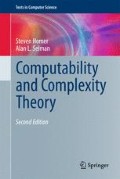Abstract
Our interest in nondeterministic polynomial time-bounded Turing machines has been concerned primarily with the question of whether, given an input x, there exists at least one accepting computation. However, this is not entirely so, for the definition of PP is that the majority of computations are accepting. Now we will be interested in the following classes, which use counting explicitly in their definitions.
Access this chapter
Tax calculation will be finalised at checkout
Purchases are for personal use only
Notes
- 1.
We can define an appropriate many-one reduction between functions in order to formalize this notion, but leave this to the reader.
- 2.
∃!x is a quantifier denoting “there exists a unique x.”
- 3.
Recall that
$${(a + b)}^{3} = {a}^{3} + 3{a}^{2}b + 3a{b}^{2} + {b}^{3}$$and
$${(a + b)}^{4} = {a}^{4} + 4{a}^{3}b + 6{a}^{2}{b}^{2} + 4a{b}^{3} + {b}^{4}.$$ - 4.
To see this, note that a 1 is added to the low order bits of the sum whenever g(〈x, y〉) is odd, and in either case (odd or even), everything else added to the sum is at least \({2}^{\vert x{\vert }^{k}+1 }\), so does not affect the low order bits.
Author information
Authors and Affiliations
Corresponding author
Rights and permissions
Copyright information
© 2011 Springer Science+Business Media, LLC
About this chapter
Cite this chapter
Homer, S., Selman, A.L. (2011). Introduction to Counting Classes. In: Computability and Complexity Theory. Texts in Computer Science. Springer, Boston, MA. https://doi.org/10.1007/978-1-4614-0682-2_11
Download citation
DOI: https://doi.org/10.1007/978-1-4614-0682-2_11
Published:
Publisher Name: Springer, Boston, MA
Print ISBN: 978-1-4614-0681-5
Online ISBN: 978-1-4614-0682-2
eBook Packages: Computer ScienceComputer Science (R0)

